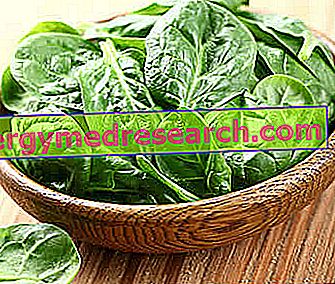What are spinach?
Spinach ( Spinacia oleracea ) are herbaceous plants belonging to the Chenopodiaceae family. They are very common foods, which in nutrition are classified in the fundamental group VI (Vegetables and Sources of Vitamin A).

In the kitchen, spinach has many uses and is extremely versatile. These vegetables can be eaten raw in salads, boiled or sautéed; play the main role of contour, but also fall into many recipes of first and second courses prepared. Some examples are: stuffing for ravioli (together with ricotta, parmesan and spices), coloring ingredient of pasta (classic green tagliatelle), stuffing of meat rolls or roasts (for example veal rolls with spinach and cheese stringy).
On an industrial level, spinach also produces a dry flour called "spinach flour".
Nutritional role
Mineralizing, antianemic and nourishing, spinach was the ideal ingredient to create the myth of the magic potion-wrenched potion.
Their fame of strongly "energetic" foods linked to the Popeye myth, besides being the result of a transcription error in reporting the iron concentration in the very early nutritional tables ("one zero too" was added), was soon put in discussion also from the discovery of oxalates; these are defined as antinutrients substances that strongly limit the bioavailability of minerals (iron, calcium, magnesium) contained in green leafy vegetables.
anti-nutrients
oxalate
Despite being very abundant, 95% of the iron contained in spinach is in any case unusable as a nutrient, due to its chemical form (ferric iron or trivalent Fe3 + iron) and the presence of oxalic acid and derivatives. Making some accounts, in the face of the most ardent vegetarians, it turns out that to absorb the equivalent in iron provided by 100 grams of meat, it is necessary to consume more than one kilogram of spinach.
The same applies to magnesium and calcium; of the latter, only 5% of the total is absorbed.
Other contraindications of oxalates
Oxalates are also harmful in the event of:
- Rheumatic forms
- Renal lithiasis (unless they are associated with abundant fluid intake)
- Osteoporosis or for those who must recover from a bone fracture (oxalic acid also severely limits the absorption of calcium).
In light of these data, it seems that the creators of the famous animated character have been mistaken. Actually it is NOT exactly like that.
Nutritional characteristics
Spinach is a low-calorie food, in which energy is supplied mainly by carbohydrates, followed by proteins and irrelevant amounts of lipids. The glucides are mainly simple and the peptides have a low biological value.
The fiber content is high, while cholesterol is absent. The amount of vitamins (both fat-soluble and water-soluble) is appreciable, as is that of mineral salts; in the following paragraphs we will go into more detail.
Spinach is not contraindicated for those suffering from obesity, metabolic pathologies, lactose or gluten intolerance. They have some drawbacks linked to the presence of certain antinutritional factors which we will discuss later on.
The average portion of spinach is 50-70 ga raw and 100-200 ga cooked.
Spinach iron
Spinach is very rich in iron; thanks to their 2.9 mg of mineral per 100 grams of fresh product, they hold the absolute primacy among vegetables. Taking a step back, let us remember that the poor bioavailability of iron in spinach is primarily caused by its chemical typology, but also by the presence of oxalates. The drawback of the chemical form is, at least minimally, resolved by the presence of vitamin C (ascorbic acid), which increases its absorption potential.
Iron is also prone to chelation of oxalates but, fortunately, these substances can be inactivated by cooking. But we must remember that it is not only oxalates that are thermolabile, but also vitamin C. This means that cooking is responsible not only for eliminating an anti-nutritional factor for iron, but also for a nutrient that would facilitate absorption.
Spinach vitamins and antioxidants
Spinach is also a good source of carotenoids (pro-vitamin A), vitamin C (ascorbic acid), folic acid, vitamin K, vitamin E, chlorophyll and lutein; discrete the amount of riboflavin (vit PP).
The combination of these micronutrients enhances their antioxidant properties, making them a particularly useful food for eye health, for those suffering from atherosclerosis, for pregnant women and for the protective action against coronary heart disease.
Raw spinach or cooked spinach?
To avoid damaging the ascorbic acid content and heat-sensitive folate, spinach should be eaten raw. Furthermore, cooking in water tends to disperse their precious mineral load by dilution; that's why, preferring to cook them, it is recommended to consume them steamed. In this case, a few drops of lemon juice will be useful to restore the concentration of vitamin C lost during cooking and necessary to increase the bioavailability of iron.
| Spinach, raw - Nutritional values per 100 g | |||
 | |||
| Power | 23 kcal | ||
| Total carbohydrates | 3.6 g | ||
| Starch | 0.4 g | ||
| Simple sugars | 3.2 g | ||
| fibers | 2.2 g | ||
| Grassi | 0.4 g | ||
| Saturated | - g | ||
| Monounsaturated | - g | ||
| polyunsaturated | - g | ||
| Protein | 2.9 g | ||
| water | 91.4 g | ||
| Vitamins | |||
| Vitamin A equivalent | 469 μg | 59% | |
| Beta-carotene | 5626 μg | 52% | |
| Lutein Zexanthin | 12198 μg | ||
| Vitamin A | 9377 IU | ||
| Thiamine or B1 | 0.078 mg | 7% | |
| Riboflavin or B2 | 0.189 mg | 16% | |
| Niacin or PP or B3 | 0.724 mg | 5% | |
| Pantothenic acid or B5 | - mg | -% | |
| Pyridoxine or B6 | 1, 195 mg | 15% | |
| Folic acid | 194.0 μg | 49% | |
| Choline | - mg | -% | |
| Ascorbic acid or C | 28.0 mg | 34% | |
| Vitamin D | - μg | -% | |
| Alpha-tocopherol or E | 2.0 mg | 13% | |
| Vit. K | 483.0 μg | 460% | |
| Minerals | |||
| Football | 99.0 mg | 10% | |
| Iron | 2.71 mg | 21% | |
| Magnesium | 79.0 mg | 22% | |
| Manganese | 0.897 mg | 43% | |
| Phosphorus | 49.0 mg | 7% | |
| Potassium | 558.0 mg | 12% | |
| Sodium | 79.0 mg | 5% | |
| Zinc | 0.53 mg | 6% | |
| Fluoride | - μg | ||
Spinach Recipes
Video - Spatzle with Spinach
Spinach is one of the characteristic ingredients of spatzle, egg pasta dumplings proposed by Alice also in the "green" and light version. Typical of northern mountainous areas and therefore not all known, spatzle "alla Mypersonaltrainer" are characterized by their rustic appearance and enveloping taste, limiting the accompanying fats.
spatzle
X Problems with video playback? Reload from YouTube Go to Video Page Go to Video Recipes Section Watch the video on youtubeAll Recipes with Spinach »



